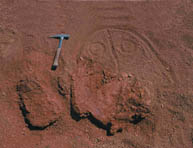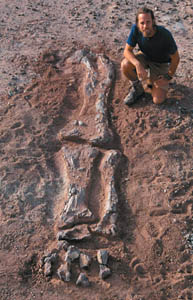Extreme Research (Page 4)
"To this point, change has best been understood by paleontologists," Carroll insists. "Now, we're beginning to look at how the genetic code was programmed to change. What, for instance, enabled a fish-like fin to evolve into a hand or a foot? This is really the cutting edge of science, and Hans brings all the applicable tools to McGill."
Larsson's research objective is to connect the dots from the what - the skeleton - to the how - genetics. Develop-mental programming imposes certain constraints at the same time as it influences change. If we could understand the underlying principles of morphology, perhaps we could map the route followed by different species from their origins to their current state.
Field and lab work are equally important to Larsson and, in fact, he refers to each as a form of exploration. In the lab, he is occupied with analyzing the fossils he brings back from field work and fitting them into their proper time sequence.


A fossilized brachiopod in Niger; Larsson with the leg of a sauropod dinosaur.
From this most recent Arctic trip, he'll be trying to determine whether migration or continental shift is the proper explanation for how the tyrannosaur ended up so far north. He claims to rely on achieving a healthy balance between the two halves of his studies to maintain his sanity.
"The field work is the most exciting part," he admits. "It's really my life. I love going off exploring in the field, seeing the world, but I also love continuing the exploration in the lab with the analysis of the data."
Natalia Rybczynski, who will co-lead the next phase of the Arctic research, describes him as "fun, ambitious and excited by the physical challenge" of field work.
Because the Arctic season is so short - no more than six weeks during the summer - Larsson expects to have plenty of time to venture elsewhere when his teaching responsibilities permit. He plans to participate in digs at Dinosaur Provincial Park in the badlands of Alberta, as well as going to Patagonia in the spring of 2004 and returning to Niger in 2005.
Reading the Past
In the human race's headlong rush into the future, we often fail to ask questions about where we've come from.
"We have so much to learn from the past," Larsson says. "How we think about modern science will be deeply affected by extrapolations from paleontology. It will explain to us how organisms have changed, which can teach us how they will change."
Evolution is not some esoteric occurrence of the past, but a process that speaks to the future. Through the explorations of scholars like Larsson, risking the extremes of both the Arctic and Africa, we can hope for a deeper appreciation of the durability, precariousness and diversity of life as it has been, is, and could turn out to be.


